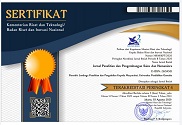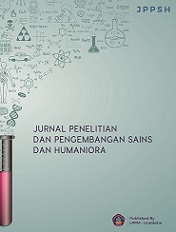An Analysis of Lexicons in Pendet Dance Movements
DOI:
https://doi.org/10.23887/jppsh.v7i1.57507Keywords:
Ecolinguistics, Lexicons, Meaning, Movements, PendetAbstract
Along with the development of the times, Balinese language and culture began to be abandoned. It is important to conduct a new study of the lexicon in art as a means of keeping the Balinese language well preserved. Therefore this study analyzed the lexicons in Pendet dance movements to respond to the Balinese language endangerment status. This study is designed in descriptive qualitative research which focused on Pendet dance lexicons as research objects. To collect the data regarding the lexicons, an observation sheet, and an interview guide were used as the instruments. The results show that there are 36 (thirty-six) lexicons in the Pendet dance. The obtained lexicons were then categorized into seven types based on body parts, namely leg movement (8), hand movement (6), finger movement (4), body movement (9), neck movement (1), eye movement (4), and expressions (4). The series of lexicons in Pendet dance have a cultural meaning which represents the beauty of Balinese women and their friendly characteristics. Thus, this study can give implications in linguistics study as preservation of the Balinese language.
References
Abdelhadi, M. (2018). Language Maintenance Factors: Reflections on the Arabic Langauge. Asia Pacific Journal of Advanced Business and Social Studies, 4(1), 340–351. https://doi.org/10.25275/apjabssv4i1ss9.
Amelinda, R., R., & Giyartini, R. (2021). Tari Egrang Batok di Sekolah Dasar. All Rights Reserved, 8(2), 508–519. https://doi.org/ejournal.upi.edu/index.php/pedadidaktika/index.
Astini, S. M., & Utina, U. T. (2007). Tari Pendet sebagai Tari Balih-Balihan ( Kajian Koreografi. Jurnal Harmonia Peng. Dan Pemikiran Seni Tari, 8(2), 170–179. https://media.neliti.com/media/publications/55941-ID-none.pdf.
Atifnigar, H., Safari, Z., & Rafat, A. H. (2021). Exploring the Causes of Language Death. A Review Paper, 4(4), 180–186. https://www.researchgate.net/profile.
Baker, C. (2001). Foundations of Bilingual Education and Bilingualism. Language Problems and Language Planningage Planning, 21(3). https://doi.org/10.1075/lplp.21.3.11fer.
Bin-Tahir, S. Z., Hanapi, H., I., & Suriaman, A. (2020). Avoiding Maluku Local Languages Death through Embedded Multilingual Learning Model. Uniqbu Journal of Social Sciences (UJSS, 1(1), 53–60. https://doi.org/https://scholar.google.co.id/scholar?hl=id&as_sdt=0%2C5&as_ylo=2020.
Bonafix, S. L., & Manara, C. (2016). Maybe English First and then Balinese and Bahasa Indonesia. Indonesian Journal of English Language Teaching, 11(1), 81–99. https://ejournal.atmajaya.ac.id/index.php/ijelt/article/download/1491/745.
Budasi, I. G., & Satyawati, M. S. (2021). An Ethnolinguistic Perspective on Lexicons of Traditional House in Menyali Village, North Bali. Jurnal Kajian Bali (Journal of Bali Studies), 11(1), 115. https://doi.org/10.24843/jkb.2021.v11.i01.p07.
Cámara-Leret, R., & Bascompte, J. (2021). Language extinction triggers the loss of unique medicinal knowledge. Proceedings of the National Academy of Sciences of the United States of America, 118(24). https://doi.org/10.1073/pnas.2103683118.
Campbell, L., & Muntzel, M. C. (2010). The Structural Consequences of Language Death. Investigating Obsolescence, 181–196. https://doi.org/10.1017/cbo9780511620997.016.
Chaer, A., & Muliastuti, L. (2012). Makna dan Semantik. Semantik Bahasa Indonesia, 5, 1–39. http://repository.ut.ac.id/4770/1/PBIN4215-M1.pdf.
Crystal, D. (2000). Language Death. In Language Death. https://doi.org/10.1017/cbo9781139106856.
Dewi, A. A. I. M. D. U., Gede Budasi, I., & Suarnajaya, I. W. (2020). Lexicons in Legong Keraton dance. Lingua Scientia, 27(2), 98–107. https://doi.org/10.23887/ls.v27i2.26422.
Dewi, D. N. D. R. (2020). Implementing Language Policy at School: The Case of Balinese Language. LINGUA SCIENTA: Journal of Foreign Language Teaching and Linguistics, 18(2), 115–134. https://repo.undiksha.ac.id/id/eprint/1902.
Farisiyah, U., & Zamzani, Z. (2018). Languange Shift and Language Maintenance of Local Languages toward Indonesian. Advances in Social Science, Education and Humanities Research, 165, 231–235. https://doi.org/10.2991/iccsr-18.2018.50.
Gukguk, S. D. R. (2018). Preeklampsia Universitas Sumatera Utara. Preeklamsia Berat. https://doi.org/repository.usu.ac.id/bitstream/123456789/30230/4/Chapter.
Hidayat, N. S. (2014). Hubungan Berbahasa, Berpikir, dan Berbudaya. Sosial Budaya, 11(2), 190–205. https://doi.org/http://ejournal.uin-suska.ac.id/index.php/SosialBudaya/article/view/834.
Indriyanto, K. (2021). an Ecolinguistics Analysis of the Wind Gourd of La’Amaomao. International Journal of Humanity Studies (IJHS, 5(1), 97–108. https://doi.org/10.24071/ijhs.v5i1.3717.
Isern, N., & Fort, J. (2014). Language extinction and linguistic fronts. Journal of the Royal Society Interface, 11(94), 2–10. https://doi.org/10.1098/rsif.2014.0028.
Janse, M. (2015). Language Death and Language Maintenance. Sociolinguistica, 4(1). https://doi.org/10.1515/9783110245097.150.
Katamba, F. (2020). A Lexicon with Layers (E. W. Taylor & F. E-Library (eds.)). https://doi.org/10.4324/9780203205280-16.
Kedrebeogo, G. (1998). Language Maintenance and Language Shift in Burkina Faso: The Case of the Koromba. Studies in the Linguistic Sciences, 28(2), 169–196. https://doi.org/http://search.proquest.com/docview/85686533.
Kokuho, M. (2020). The Transformation of Dance Instruction in Bali, Indonesia. International Journal of Sport and Health Science, 18(0), 180–188. https://doi.org/10.5432/ijshs.201927.
Krismayani, ni wayan, Suastra, I. M., & Suparwa, i nyoman. (2021). Ecolinguistic Approaches in Development of English Teaching Materials for English for Business. E-Journal of Linguistics, 15(1), 16–24. https://doi.org/https://doi.org/10.24843/e-jl.2021.v15.i01.p03 Ecolinguistic
Kusuma, D. A. D. (2022). The Phonological Interference of Balinese Language of Jagaraga Dialect in English Pronunciation: Interferensi Fonologi Bahasa Bali Dialek Jagaraga dalam Pengucapan Bahasa Inggris. Jurnal Pendidikan Multikultural Indonesia, 5(1). https://doi.org/10.23887/jpmu.v5i1.50406.
Kusuma, W. I. M. A., Budasi, I. G., & Suarnajaya, I. W. (2020). Lexicons of Tabuh Rah Used in Menyali Village. Prasi, 15(2), 71. https://doi.org/10.23887/prasi.v15i02.26906.
Lail, J., & Widad, R. (2015). Belajar Tari Tradisional Dalam Upaya Melestarikan Tarian Asli Indonesia. Inovasi Dan Kewirausahaan, 4(2), 102–104. https://doi.org/http://www.pakmono.com/2014/12.
Lihawa, K. (2017). Leksikon dan Nilai-Nilai Budaya dalam Ritual Momeqati. https://repository.ung.ac.id/karyailmiah/show/6238.
Lilik, L., & Mertayasa, I. K. (2019). Esensi Tri Hita Karana Perspektif Pendidikan Agama Hindu. Bawi Ayah: Jurnal Pendidikan Agama Dan Budaya Hindu, 10(2), 60–80. https://doi.org/10.33363/ba.v10i2.373.
Mahadi, T. S., & Jafari, S. M. (2012). Language an Culture. International Journal of Humanities and Social Science, 2(17), 230–235. https://www.ijhssnet.com/journals/Vol_2_No_17_September_2012/24.pdf.
Malini, N. N. S., Laksminy, L. P., & Sulibra, N. K. N. (2017). The System of Balinese Language Inheritance at International Tourism Destinations in Bali. Udayana Journal of Social Sciences and Humanities, 1(1), 63. https://doi.org/10.24843/ujossh.2017.v01.i01.p10.
Mariasa, I. N. (2013). Bima Suci Sebuah Koreografi Kontemporer pada Acara Serah Terima Jabatan Komandan Lantamal Vaal Surabaya. Jurnal Mahasiswa Universitas Negeri Surabaya, 2(1), 1–11. https://core.ac.uk/download/pdf/230780528.pdf.
Mariasa, I. N. (2019). Pendet ‘Berbaju’ A Subjective Aesthetic Image (Vol. 301, pp. 111–116). https://doi.org/10.2991/icla-18.2019.18.
Marjanto, D. K., Widjaja, I., Julizar, K., Hendrik, H., & Ulumuddin, I. (2020). Pengaruh Pendaftaran Tiga Genre Tari dalam Daftar ICH UNESCO bagi Kehidupan Sosial Ekonomi Komunitas Budaya (First Edit). Pusat Penelitian Kebijakan, Badan Penelitian dan Pengembangan dan Perbukuan, Kementerian Pendidikan dan Kebudayaan.
Martozet, M. (2021). The Existency of Traditional and Modern Dance in Medan City. Budapest International Research and Critics in Linguistics and Education (BirLE) Journal, 4(1), 203–212. https://doi.org/10.33258/birle.v4i1.1574.
Miles, M. B., Michael Huberman, A., & Saldaña, J. (2014). Qualitative data analysis: A methods Sourcebook (3rd Edition). In SAGE Publications, Inc. https://doi.org/10.1177/239700221402800402.
Nirwani, I. I. (2018). Pandangan Hidup Masyarakat Sasak dalam Leksikon Nama Sѐsѐkan: Sebuah Tinjauan Linguistik Antropologi. Deskripsi Bahasa, 1(2), 138–152. https://doi.org/10.22146/db.v1i2.331.
Nurharini, A., & Ratnaningrum, I. (2020). Analysis of Traditional Dance Education in Cultural Phenomenon. Sembadra, Journal of Arts And, 2(2), 73–78. https://doi.org/https://journal.unesa.ac.id/index.php/Sembadra/article/view/11265.
Putri, I. G. A. V. W., & Nurita, W. (2021). Critical condition in Balinese lexicon extinction. Journal of Language and Linguistic Studies, 17(4), 1773–1786. https://doi.org/10.52462/jlls.129.
Rochayati, R. (2017). Seni Tari Antara Ruang Dan Waktu. Jurnal Sitakara, 2(2). https://doi.org/10.31851/sitakara.v2i2.1194.
Sandelowski, M. (2000). Focus on research methods: Whatever happened to qualitative description? Research in Nursing and Health, 23(4), 334–340. https://doi.org/10.1002/1098-240x(200008)23:4.
Satriawati. (2018). Seni Tari. In Pusat Kegiatan Belajar Masyarakat PKBM Rumahbuku Carabaca. https://www.researchgate.net/publication/269107473.
Stuti, N. N. W., Ramendra, D. P., & Utami, I. A. M. I. (2018). the Jargons Used By Balinese Dancer of Female At Sanggar Seni Manik Uttara. Language and Education Journal Undiksha, 1(1), 41–52. https://doi.org/10.23887/leju.v1i1.20251.
Suandi, I. N., & Sutama, I. M. (2021). Balinesse Language Elucidation as an Attempt to Preserve Balineese Language in Bali Province. Proceedings of the 2nd International Conference on Technology and Educational Science (ICTES 2020, 540(Ictes 2020), 305–309. https://doi.org/10.2991/assehr.k.210407.256.
Sugiartha, I. G. A. (2018). Relation of Dance and Music to Balinese Hinduism. SPAFA Journal, Journal of Archaeology and Fine Arts in Southeast Asia, 2, 1–17. https://doi.org/https://www.spafajournal.org/index.php/spafajournal/article/view/564/593.
Supartama, I. G. M. B., & Sukadana, I. W. (2020). Tari Bali: Tantangan dan Solusi di Era Globalisasi. WIDYANATA, 2(1), 57–62. https://doi.org/10.1088/1751-8113/44/8/085201.
Sustiawati, N. L., Arini, A. K., Suci, N. N., Armini, N. L., & Sukasih, N. N. (2011). Pengetahuan Seni Tari Bali. PT. Empat Warna Komunikasi.
Tarigan, K. E., & Widayati, D. (2021). An Approach of Ecolinguistic in Minyak Karo based on Ethnobotany. Nusantara Hasana Journal, 1(4), 108–120.
Wiweka, K. (2014). Analisis Konsep Tri Hita Karana Pada Daya Tarik Warisan Budaya: Studi Kasus Puri Agung Karangasem, Bali. Jurnal Master Pariwisata (JUMPA), 01, 139–160. https://doi.org/10.24843/jumpa.2014.v01.i01.p07.
Wu, Y. (2018). Ecological Discourse Analysis (Vol. 181, pp. 646–649). https://doi.org/10.2991/icsshe-18.2018.163
Yayuk, R. (2018). Leksikon Pengungkap Karakteristik Budaya Sungai Masyarakat Banjarmasin Dan Nagara: Telaah Etnosemantis (Lexicon of Characteristic Disclosure of River Culture At Banjarmasin and Nagara Societies: an Ethnosemantic Study. Naditira Widya, 12(2), 131. https://doi.org/10.24832/nw.v12i2.312.
Yuniawan, T. (2017). Ecolinguistic Study of Conservation News Texts in Indonesian Mass Media. International Journal of Humanity Studies, 1(2), 163–183. https://doi.org/10.24071/ijhs.2018.010203.
Downloads
Published
Issue
Section
License
Copyright (c) 2023 Pande Eka Putri Pradnyani, I Gede Budasi, Dewa Ayu Eka Agustini

This work is licensed under a Creative Commons Attribution-ShareAlike 4.0 International License.
Authors who publish with the Jurnal Penelitian dan Pengembangan Sains dan Humaniora agree to the following terms:
- Authors retain copyright and grant the journal the right of first publication with the work simultaneously licensed under a Creative Commons Attribution License (CC BY-SA 4.0) that allows others to share the work with an acknowledgment of the work's authorship and initial publication in this journal.
- Authors are able to enter into separate, additional contractual arrangements for the non-exclusive distribution of the journal's published version of the work (e.g., post it to an institutional repository or publish it in a book), with an acknowledgment of its initial publication in this journal.
- Authors are permitted and encouraged to post their work online (e.g., in institutional repositories or on their website) prior to and during the submission process, as it can lead to productive exchanges, as well as earlier and greater citation of published work. (See The Effect of Open Access)









